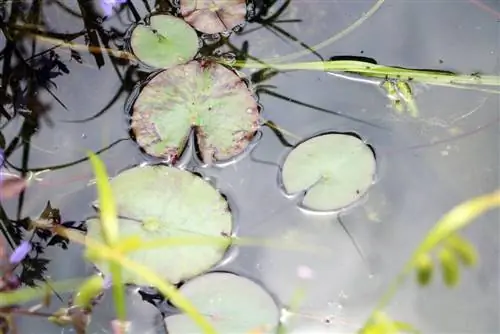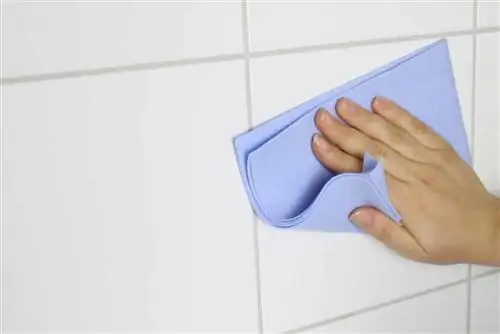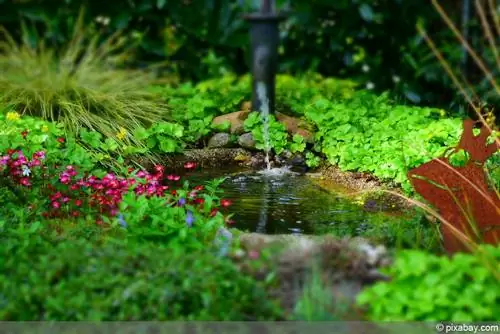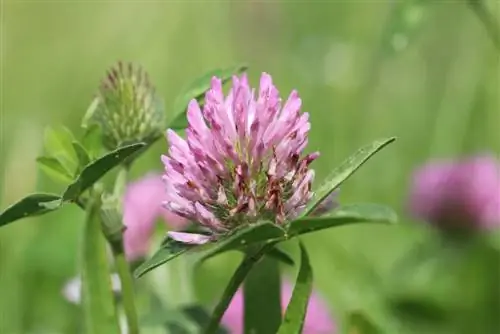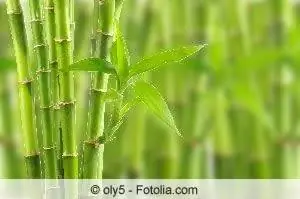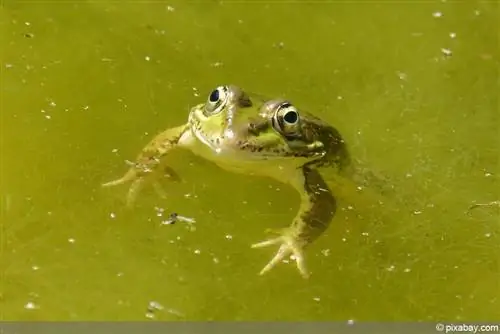- Author admin [email protected].
- Public 2023-12-17 03:39.
- Last modified 2025-01-24 12:45.
If the garden pond turns reddish, red algae is usually at work. Red algae are algae that take on a red color through photosynthesis. The red algae group includes beard algae and brush algae. If the pond is contaminated with red algae, in addition to combating it, the cause of the strong algae growth should also be eliminated. Red algae infestation can be recognized by the reddish and cloudy discoloration of the pond water. In the worst case, the oxygen concentration in the pond water can drop so much that the fish suffocate in the water and the pond tips over.
Causes of red algae in the garden pond
- Red algae are often found in heavily filtered pond tanks.
- If there is a CO² deficiency in the pond, the disturbing algae multiply very quickly.
- Furthermore, a high nutrient content in the water (increased nitrate and phosphate levels) leads to increased growth in the garden pond.
- Red algae are also characterized by the fact that they show great growth even in good lighting conditions.
- For this reason, they are often found when a garden pond is exposed to intense sunlight.
Mechanical combat
First, it is advisable to remove the red algae mechanically. In addition to the red algae, infected plants and leaves must also be completely removed from the pond and replaced with new ones. The CO² value of the water is also important: This should be between 10 and 20 milligrams/liter and can also be increased to 30 milligrams per liter of pond water if the pond shows strong algae growth. As long as the combination of nutrients in the pond is balanced, plants and animals live in peaceful coexistence. But if the phosphate content increases, the red algae multiply because their living conditions improve. Rising water temperatures and increased sunlight can lead to a real algae bloom. The iron content of the water is also responsible for algae growth. Regular water changes must be carried out in order to banish pests from the garden pond in the long term. The amount of water in the garden pond should also be increased if possible and kept constant.
Renovation of the garden pond
Red algae can also be removed and combated sustainably through pond renovation. The layer of mulch on the ground consists of fish droppings and rotten plants. This must be carefully removed and replaced with new pond soil. Care should be taken to ensure that the new pond soil is low in nutrients. All plants are generously pruned and divided. The plants are then replanted in the nutrient-poor pond soil. Slope mats or plant baskets can also be used.
Reduce phosphate content in water
Nutrients and phosphates enter the garden pond through excess fish food and fish feces. Fish droppings and food sink to the bottom of the pond and are broken down into their components. During heavy rain, nutrient-rich garden soil and lawn fertilizer are also washed into the pond. Likewise, leaves that fall into the garden pond contain phosphates and other nutrients that promote algae growth. In order to reduce algae growth and combat it sustainably, the nutrients should be removed from the pond water. In addition to the algae, the plants in the water also need nutrients. The more aquatic plants live in the pond, the faster the nutrients can be bound as the plants grow. Unfortunately, the result is increased algae infestation. Aquatic plants that are not infected should therefore be cut back heavily and regularly. Regular fishing for red algae also reduces the nutrient content in the pond water. A mineral binder (phosphate binder) ensures that the phosphate content in the pond water is reduced. Nutrients cannot be absorbed by the red algae through the phosphate binder because they are bound by the chemical process.
Elevation and pond drainage
In order to permanently remove red algae and maintain clear pond water, it is important to eliminate all phosphate sources. The course can be set as soon as the pond is created. The body of water lies most naturally in a depression. However, this situation poses the risk of mineral fertilizers or garden soil being washed into the pond. A slightly elevated place helps here. If possible, the garden pond should be surrounded with a drainage ditch approx. 60 cm deep, which should be filled with coarse-grained building sand.
Light conditions and water
Sunlight promotes algae growth. A location that is in the shade prevents red algae infestation. At least two thirds of the pond should be in the shade. Water depth and amount of water also influence algae growth. The shallower and smaller the body of water, the greater the algae growth.
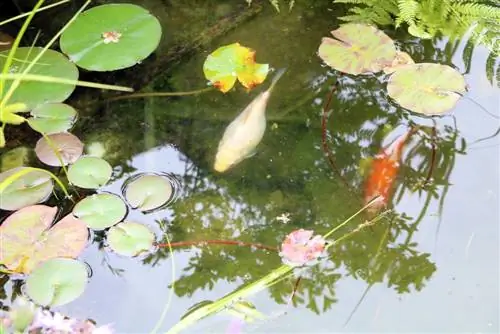
Tested tap water is best for filling the pond. Tap water often contains up to 5 milligrams of phosphate per liter of water. You should ask here and use a phosphate binder if the phosphate content is increased. Groundwater is generally better suited for filling the pond because it is low in phosphate.
Proper care
Nutrient-rich deposits can also form in seemingly clear pond water. Special pond sludge vacuum cleaners can help here. Regular vacuuming ensures lasting protection against red algae. In addition, the pond should be protected with a net in the autumn months so that no leaves get into the pond. It is also advisable to regularly remove floating foreign bodies such as pollen, etc. from the pond surface. “Skimmers” are suitable here, with which the water on the surface can be easily sucked out. If there are fish or other aquatic animals in the pond, their excretions can increase the phosphate content. As long as no fish food is added, the natural balance in the pond is maintained. However, if the pond is regularly supplied with fish food, it receives additional nutrients that encourage the pond to tip over. Fewer fish can feed themselves in the pond. Here it is advisable to reduce the number of fish or install a filter system that effortlessly removes excess nutrients and algae. In order to remove red algae sustainably, extensive measures are necessary that overlap with one another and must be carried out regularly.
What you should know about red algae in brief
- The different types of red algae have their habitat in fresh and s alt water.
- There are mainly two types of red algae found in the aquarium, namely the beard algae and the brush algae.
- The s altwater aquarium, on the other hand, is home to a large number of different types of red algae.
The difference between the appearance of red algae in freshwater aquariums and appearance in s altwater aquariums is that they are often desirable in s altwater aquariums because they occur in a wide variety of red tones and thus create a beautiful effect. However, the species that are found in freshwater aquariums tend to be gray to black and therefore there can be no question of a beautiful effect. The fact that brush and beard algae belong to the red algae can only be recognized with the help of alcohol. If you put them there, their bright red color will appear.
Unfortunately, brush and beard algae are among the most common and stubborn algae found in aquariums. It has not yet been clarified which factors must work together so that red algae can develop in freshwater aquariums. The only knowledge that has been gained with certainty so far is that red algae feel most comfortable in heavily filtered aquariums. If there is also poor plant growth, the red algae often and regularly become a real pest.
- Like any type of algae infestation, red algae can be prevented by changing the water more frequently.
- To counteract an oversupply of nutrients, you can use fast-growing plants.
- It is also important that there are not too many fish in the aquarium.
In this context, care must be taken not to offer too much food that the fish do not eat because they are not hungry. Since the beard and brush algae prefer highly filtered water, you should reduce the filter performance.

